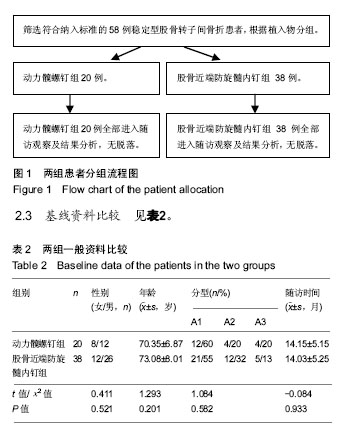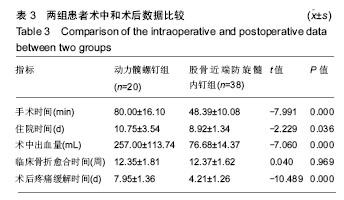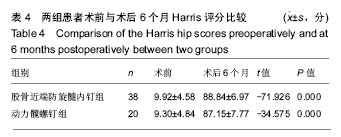| [1] Guo Y, Yang H P, Dou Q J, et al. Efficacy of femoral nail anti-rotation of helical blade in unstable intertrochanteric fracture. Eur Rev Med Pharmacol Sci. 2017;21(3 Suppl):6-11.[2] Berger-Groch J, Rupprecht M, Schoepper S, et al. Five-year outcome analysis of intertrochanteric femur fractures: a prospective randomized trial comparing a 2-screw and a single-screw cephalomedullary nail. J Orthop Trauma. 2016; 30(9):483-488.[3] Gormeli G, Korkmaz MF, Gormeli CA, et al. Comparison of femur intertrochanteric fracture fixation with hemiarthroplasty and proximal femoral nail systems. Ulus Travma Acil Cerrahi Derg. 2015;21(6):503-508.[4] Stern R. Are there advances in the treatment of extracapsular hip fractures in the elderly? Injury. 2007;38 Suppl 3:S77-S87.[5] Muncibi F, Petrai V, Nistri L, et al. Advances in the surgical treatment of fragility fractures of the upper femur. Clin Cases Miner Bone Metab. 2009;6(3):197-202.[6] Ding T, Zhang B, Tian S, et al. [Selection principles and application status of surgical methods for hip fracture in the elderly]. Zhongguo Xiu Fu Chong Jian Wai Ke Za Zhi. 2018; 32(11):1435-1440.[7] Barton TM, Gleeson R, Topliss C, et al. A comparison of the long gamma nail with the sliding hip screw for the treatment of AO/OTA 31-A2 fractures of the proximal part of the femur: a prospective randomized trial. J Bone Joint Surg Am. 2010; 92(4):792-798.[8] Socci AR, Casemyr NE, Leslie MP, et al. Implant options for the treatment of intertrochanteric fractures of the hip: rationale, evidence, and recommendations. Bone Joint J. 2017;99-B(1): 128-133.[9] Jensen JS, Sonne-Holm S, Tondevold E. Unstable trochanteric fractures. A comparative analysis of four methods of internal fixation. Acta Orthop Scand. 1980;51(6):949-962.[10] Sharma A, Mahajan A, John B. A Comparison of the Clinico-Radiological Outcomes with Proximal Femoral Nail (PFN) and Proximal Femoral Nail Antirotation (PFNA) in Fixation of Unstable Intertrochanteric Fractures. J Clin Diagn Res. 2017;11(7):C5-C9.[11] Jia L, Zhang K, Wang ZG, et al. Proximal femoral nail antirotation internal fixation in treating intertrochanteric femoral fractures of elderly subjects. J Biol Regul Homeost Agents. 2017;31(2):329-334.[12] Ma KL, Wang X, Luan FJ, et al. Proximal femoral nails antirotation, Gamma nails, and dynamic hip screws for fixation of intertrochanteric fractures of femur: A meta-analysis. Orthop Traumatol Surg Res. 2014;100(8):859-866.[13] 聂治军,常彦海,袁启令,等. 三种手术方式治疗高龄不稳定性股骨粗隆间骨折的对比研究[J].中华关节外科杂志(电子版), 2017, 11(2):17-23.[14] 程建,雷会宁,冯仕明,等. PFNA与DHS治疗不稳定型股骨粗隆间骨折的Meta分析[J]. 重庆医学, 2016,45(21):2956-2961.[15] Singh AK, Narsaria N, G RA, et al. Treatment of unstable trochanteric femur fractures: proximal femur nail versus proximal femur locking compression plate. Am J Orthop (Belle Mead NJ). 2017;46(2):E116-E123.[16] 王武,翟生,韩小平,等. 股骨近端抗旋髓内钉与动力髋螺钉对老年不稳定股骨粗隆间骨折疗效的对比研究[J]. 中华医学杂志, 2018,98(5):357-361.[17] Shin YS, Chae JE, Kang TW, et al. Prospective randomized study comparing two cephalomedullary nails for elderly intertrochanteric fractures: Zimmer natural nail versus proximal femoral nail antirotation II. Injury. 2017;48(7): 1550-1557.[18] Lee CH, Su KC, Chen KH, et al. Impact of tip-apex distance and femoral head lag screw position on treatment outcomes of unstable intertrochanteric fractures using cephalomedullary nails. J Int Med Res. 2018;46(6):2128-2140.[19] 吴在德,吴肇汉,郑树,等. 外科学[M]. 7版. 北京:人民卫生出版社, 2008.[20] Harris WH. Traumatic arthritis of the hip after dislocation and acetabular fractures: treatment by mold arthroplasty. An end-result study using a new method of result evaluation. J Bone Joint Surg Am. 1969;51(4):737-755.[21] Matassi F, Carulli C, Munz G, et al. Preliminary results of an early vs delayed timing of surgery in the management of proximal femur fragility fractures. Clin Cases Miner Bone Metab. 2015;12(1):11-17.[22] Yonezawa T, Yamazaki K, Atsumi T, et al. Influence of the timing of surgery on mortality and activity of hip fracture in elderly patients. J Orthop Sci. 2009;14(5):566-573.[23] Steinberg EL, Blumberg N, Dekel S. The fixion proximal femur nailing system: biomechanical properties of the nail and a cadaveric study. J Biomech. 2005;38(1):63-68.[24] Xie H, Wang Z, Zhang J, et al. Clinical outcome of dynamic hip locking plates and proximal femoral nails anti-rotation-Asia for treating intertrochanteric femur fracture with lateral wall fractures in the elder patients. Oncotarget. 2017;8(47):82700-82704.[25] Carulli C, Piacentini F, Paoli T, et al. A comparison of two fixation methods for femoral trochanteric fractures: a new generation intramedullary system vs sliding hip screw Clin Cases Miner Bone Metab. 2017;14(1):40-47.[26] Sharma A, Sethi A, Sharma S. Treatment of stable intertrochanteric fractures of the femur with proximal femoral nail versus dynamic hip screw: a comparative study. Rev Bras Ortop. 2018;53(4):477-481.[27] 徐驰,周勇,赵军,等. PFNA治疗老年股骨转子间骨折的隐性失血分析[J]. 中国矫形外科杂志, 2018,26(6):510-515.[28] 吴强,杨旭,王欣. 髓内固定对股骨转子间骨折隐性失血的影响[J]. 中华实验外科杂志, 2017,34(4):630.[29] 龙秋平,廖前德,尹科,等. 股骨转子间骨折两种置入内固定的隐性失血比较[J]. 中国组织工程研究, 2013,17(30):5460-5465.[30] 王峰,李振武,尹锐锋,等. 老年股骨转子间骨折围修复期隐性失血量与内固定植入物及性别的关系[J]. 中国组织工程研究, 2016,20(4):544-548. |
.jpg)




.jpg)
.jpg)